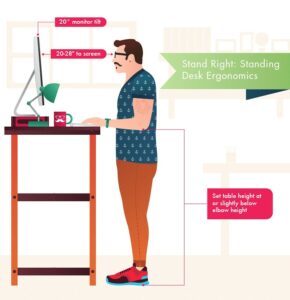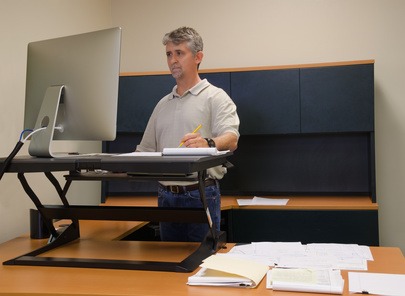Maybe you’ve wondered if the fancy stand-up desk your company purchased for your colleague is a waste of money and just the latest “shiny object.” Or perhaps you’ve considered one for your home office but aren’t really sure if the claims of increased health and productivity are true. A study from Texas A&M University found that employees who used sit-stand desks were 46% more productive than those at traditional desks. In addition, numerous research studies show that too much sitting can cause a decrease in overall health and productivity. Apparently this latest “shiny object” is here to stay. A team at ConsumersAdvocate.org recently researched the most popular standing desk models and found which ones lead the market based on features, affordability, and customer experience. In addition, they offer some helpful tips when looking for standing desks, outlining the important features, warranty options, and how to properly use them.
Tips for Choosing a Desk
- Test the theory. See if you like standing while you work. Use your kitchen counter, your washing machine, or any other surface that’s ergonomically correct for your body. Chances are, you may even have a friend who uses a standing desk; see if you can use it for a couple hours before spending the money to invest in your own.
- Check out maximum height. Desks should accommodate a wide variety of body types, so make sure they can reach at least 48 inches, with a 20-inch sit-to-stand range, which is ergonomically okay for anyone up to 6 feet 7 inches.
- Look for great warranties. A standing desk can be a major expense, especially for companies looking to furnish their offices — one desk can cost anywhere from a few hundred dollars up to $4,000. For those more expensive desks, be sure it offers a frame and electronics warranty of at least five years.
- Make sure the desks are easy to assemble. How will the desk arrive? In how many boxes? How quick and easy will it be to assemble?
 Using Your New Desk
Using Your New Desk
Once you’ve chosen and assembled your standing desk, it’s important you are using it properly. Did you know there is a right way and a wrong way to use a standing desk? Ergonomics are key. The top of your monitor should be at or just below eye level (make sure your head isn’t angled down), and your eyes should be 20 to 28 inches from the screen. Keep your upper arms close to your body, your wrists straight, and your hands at or below wrist level. The table height of a standing desk should be at or slightly below elbow height — basically make a 90-degree angle with your elbow. Your head, neck, and torso should be in line, and your keyboard and mouse should be at the same level. Got that? If not, here’s a graphic that sums it all up, courtesy of CustomMade.
Remember to Move
There are downsides to sitting too long and also to standing too long. Purchasing a standing desk won’t solve these problems unless you remember to change your posture. From the words of Dr. Lucas Carr, an expert in physical activity promotion and sedentary behaviors, “Our bodies were designed to move periodically throughout the day. I advise people to stand up, stretch, and take a short walk (if possible) if you feel you’ve been sitting for too long.”
If you would like to learn more about which standing desks ConsumersAdvocate.org chose as their top picks check out the rest of their guide here.


Thanks Lori! I often get questions about standing desks. Do you suggest a stand alone product or one that sits on top of an existing desk? What about storage like in traditional desk drawers?
Thanks for the question Ellen. I think it’s a matter of personal preference, budget and style. I have clients who use both and like them. Typically, I see the stand-alone desks in a corporate setting and the portable one in a home setting but it doesn’t have to be. Of course, the stand-alone will usually be more expensive. For desks without drawers, you could add a free-standing cabinet.
Lori, thanks for writing this timely article. I personally like the “perched (leaning)” option since it provides good support while encouraging some core activation. Here is a link to more info: https://www.workwhilewalking.com/focal-locus-leaning-standing-desk-workstation-reviews.
Thanks again,
Jon Schultz, PT
Thanks for sharing this, Jon. It looks like a great option that I personally hadn’t seen before. I like the idea of core activation while you work – many benefits involved there. Is it potentially hard on shoulders or neck in that position? Thanks again.